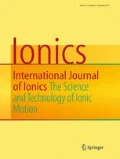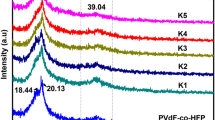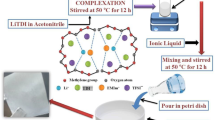Abstract
Gel electrolytes and solid electrolytes have been reported as a potential element to slow down the polysulfide shuttle by reducing its mobility in the electrolytes. The preparation of sulfur-conductive polymer composites, or sulfur-carbon composites, has been reported as softening the impact of the shuttle effects. Unlike Li-ion batteries so far, no electrolyte is found to be optimal for Li–S batteries at all conditions. Taking into account all these factors, in the present study, an attempt has been made to develop solid polymer electrolytes in conjunction with non-aqueous liquid electrolytes along with inert fillers for Li–S batteries. Poly-ethylene oxide (PEO)-based composite gel polymer electrolytes (CGPE) comprising a combination of plasticizers, namely 1,3-dioxolane (DIOX)/tetraethylene glycol dimethylether (TEGDME) and a lithium salt (LiTf) with the addition of ceramic filler, barium titanate (BaTiO3) have been prepared using a simple solution casting technique in an argon atmosphere. The as-prepared polymer electrolyte films were subjected to SEM, ionic conductivity, TG/DTA, and FTIR analyses. A symmetric cell composed of Li/CGPE/Li was assembled, and the variation of interfacial resistance as a function of time was also measured. The ionic conductivity was found to be increased as a function of temperature. The lithium transference number (Lit +) was measured, and the value was calculated as 0.7 which is sufficient for battery applications. The electrochemical stability window of the sample was studied by linear sweep voltammetry, and the polymer electrolyte film was found to be stable up to 5.7 V. The TG/DTA analysis reveals that this CGPE is thermally stable up to 350 °C. The compatibility studies exhibited that CGPE has better interracial properties with lithium metal anode. The interaction between the PEO and salt has been identified by an FTIR analysis.








Similar content being viewed by others
References
Whittingham MS (2004) Lithium batteries and cathode materials. Chem Rev 104:4271
Armand M, Tarascon JM (2008) Building better batteries nature publishing group. Nature 451:652–657
Tarascon JM, Armand M (2001) Issues and challenges facing rechargeable lithium batteries. Nature 414:359–367
Ohzuku T, Brodd RJ (2007) An overview of positive-electrode materials for advanced lithium-ion batteries. J Power Sources 174(2):449–456
Iriyama Y, Yada C, Abe T, Ogumi Z, Kikuchi K (2006) A new kind of all-solid-state thin-film-type lithium-ion battery developed by applying a DC high voltage. Electrochem Commun 8:1287–1291
Liao X-Z, Ma Z-F, Gong Q, He Y-S, Pei L, Zeng L-J (2008) Low-temperature performance of LiFePO4/C cathode in a quaternary carbonate-based electrolyte. Electrochem Commun 10:691–694
Zhang P, Zhang HP, Li GC, Li ZH, Wu YP (2008) A novel process to prepare porous membranes comprising SnO2 nanoparticles and P(MMA-AN) as polymer electrolyte. Electrochem Commun 10:1052–1055
Garche J, Scrosati B (2010) Lithium batteries: status, prospects and future. J Power Sources 195:2419
Peled E, Sternberg Y, Gorenshtein A, Lavi Y (1989) Lithium-sulfur battery: evaluation of dioxolane-based electrolytes. J Electrochem Soc 136:1621–1625
Rauh RD, Shuker FS, Marston JM, Brummer SB (1977) Formation of lithium polysulfides in aprotic media. J Inorg Nucl Chem 39:1761–1766
Paris J, Plichon V (1981) Electrochemical reduction of sulfur in dimethylacetamide. Electrochem Acta 26:1823
Shriver D. F. and Farrington G. C., (1985) Solid ionic conductors. Chem Eng News 63:42
Armand MB (1983) Lithium intercalation in polyacetylene. Solid State Ionics 9&10:745
Le Nest JF, Gandini A, Cheradame H (1988) Crosslinked polyethers as media for ionic conduction. British Polym J 20:253
Croce F, Appetecchi GB, Persi L, Scrosati B (1998) Nanocomposite polymer electrolytes for lithium batteries. Nature 394:456–458
Manuel Stephan A, Karan RT, Renganathan NG, Pitchumani S, Muniyandi N, Ramamoorthy P (1999) A study on polymer blend electrolytes based on PVC/PMMA with lithium salt. J Power Sources 752:81–82
Manuel Stephan A, Kumar TP, Karan RT, Renganathan NG, Pitchumani S, Shrisudersan J et al (2000) Ionic conductivity studies on plasticized PVC/PMMA blend electrolytes containing LiBF4 and LiCF3SO3 with lithium salt. Solid State Ionics 130:123
Manuel Stephan A, Kumar TP, Karan RT, Renganathan NG, Pitchumani S, Muniyandi N et al (2000) A study on polymer blend electrolytes based on PVC/PMMA with lithium salt. J Power Sources 83:80
Evans J, Vincent CA, Bruce PG (1987) Electrochemical measurement of transference numbers in polymer electrolytes. Polymer 28:2324–2328
Shin JH, Alessandrini F, Passerini S (2005) Comparison of solvent-cast and hot-pressed P(EO)20LiN (SO2CF2CF3)2 polymer electrolytes containing nanosized SiO2. J Electrochem Soc 152:A283
Appetecchi GB, Hassoun J, Scrosati B, Croce F, Cassel F, Solomon M (2003) Hot-pressed, dry, composite, PEO-based electrolyte membranes: I. Ionic conductivity characterization. J. Power Sources 124:246
Croce F, Curini R, Martinelli A, Persi L, Ronci F, Scrosati B, Caminiti R (1999) Physical and chemical properties of nanocomposite polymer electrolytes. J Phys Chem B 103:10632
Ratner M.A. (1987) Polymer Electrolyte Reviews-1. In: MacCallum JR, Vincent CA (eds). Elsevier Applied Science, London
Robitailla CD, Fauteux D (1986) Phase diagrams and conductivity characterization of some PEO-LiX electrolytes. J Electochem Soc 133:133–315
Capiglia C, Mustarelli P, Quartarone E, Tomasi C, Magistris A (1999) Effects of nanoscale SiO2 on the thermal and transport properties of solvent-free, poly (ethylene oxide ) (PEO)- based polymer electrolytes. Solid State Ionics 118:73–79
Vilano P, Carewska M, Appetecchi GB, Passerini S (2002) PEO-LiN(SO2CF2CF3)2 polymer electrolytes III. Tests in batteries. J Electrochem Soc 149:A1282
Lee HS, Yang XQ, McBreen J, Xu ZS, Skotheim TA, Okamoto Y (1994) Ionic conductivity of a polymer electrolyte with modified carbon as a plasticizer for poly(ethylene oxide). J Electrochem Sci 141:886–889
Mohamed NS, Arof AK (2004) Conductivity studies of LiCF3SO3 doped and DMF-plasticized PVDF-based solid polymer electrolytes. Phys Status Solidi A 201:3096–3101
Cernea M (2005) Sol-gel synthesis and characterization of BaTiO3 powder. J Optoelectr Adv Mater 7:3015–3022
Arya PR, Jha P, Ganguli AK (2003) Synthesis, characterization and dielectric properties of nanometer-sized barium strontium titanates prepared by the polymeric citrate precursor method. J Mater Chem 13(2):415–423
Wei X, Xu G, Ren Z, Shen G, Han G (2008) Room-temperature synthesis of BaTiO3 nanoparticles in large batches. J Am Ceram Soc 91:3774
Ribeiro R, Silva GG, Mohallen NDS (2001) A comparison of ionic conductivity, thermal behaviour and morphology in two polyether-LiI-LiAl5O8 composite polymer electrolytes. Electrochim Acta 46:1679
Shodai T, Owens BB, Ostsuka M, Yamak J (1994) Thermal stability of polymer electrolyte (PEO)8 LiCF3SO3. J Electrochem Soc 141:2978
Chu PP, Reddy MJ, Kao HM (2003) Novel composite polymer electrolyte comprising mesoporous structured SiO2 and PEO/Li. Solid State Ionics 156:141
Chiang CY, Reddy MJ, Chu PP (2004) Nano-tube TiO2 composite PVdF: LiPF6 solid membranes. Solid State Ionics 175:631
De Costa VM, Fiskev TG, Coleman LB (1994) Far infrared reflection-absorption spectroscopy of thin polyethylene oxide films. J Chem Phys 101:2746
Fernicola A, Croce F, Scrosati B, Watanabe T, Ohno H (2007) LiTFSI-BEPyTFSI as an improved ionic liquid electrolyte for rechargeable lithium batteries. J Power Sources 174:342–348
Angulakshmi N, Senthil KR, Anbu KM, Manuel SA (2014) composite polymer electrolytes encompassing metal organic frame works: a new strategy for all-solid-state lithium batteries. J Phys Chem C 118:24240–24247
Peled E, Golodnitsky D, Ardel G (1997) Advanced model for solid electrolyte interphase electrodes in liquid and polymer electrolytes. J Electrochem Soc 144:L208–L210
Stephan M, Prem Kumar A, Anbu Kulandainathan T, Angulakshmi M (2009) Chitin incorporated poly (ethylene oxide)-based nanocomposite electrolytes for lithium batteries. J Phys Chem B 113:1963–1971
Li Q, Sun HY, Takeda Y, Imanishi N, Yang J, Yamamoto O (2001) Interface properties between a lithium metal electrode and a poly(ethylene oxide) based composite polymer electrolyte. J Power Sources 94:201–205
Liu S, Wang H, Imanishi N, Zhang T, Hirano A, Takeda Y, Yamamoto O, Yang J (2011) Effect of co-doping nano-silica filler and N-methyl-N-propylpiperidinium bis(trifluoromethanesulfonyl)imide into polymer electrolyte on Li dendrite formation in Li/poly(ethylene oxide)-Li(cf3so2)2n/Li. J Power Sources 196:7681–7686
Tsao CH, Hsiao YH, Hsu CH, Kuo PL (2016) Stable lithium deposition generated from ceramic-cross-linked gel polymer electrolytes for lithium anode. ACS Appl Mater Interfaces 8(24):15216–15224
Croce F, Sacchetti S, Scrosati B (2006) Advanced, lithium batteries based on high-performance composite polymer electrolytes. J Power Sources 162:685
Appetecchi GB, Romagnoli P, Scrosati B (2001) Composite gel membranes: a new class of improved polymer electrolytes for lithium batteries. Electrochem Commun 3:281
Kang W, Deng N, Ju J, Li Q, Wu D, Ma X, Li L, Naebe M, Cheng B (2016) A review of recent developments in rechargeable lithium–sulfur batteries. Nano 8:16541–16588
Shim J, Striebel KA, Cairns (2002) The lithium/sulfur rechargeable cell. J Electrochem Soc 149:A1321–A1325
Author information
Authors and Affiliations
Corresponding author
Rights and permissions
About this article
Cite this article
Nagajothi, A.J., Kannan, R. & Rajashabala, S. Electrochemical performance of plasticized PEO-LiTf complex-based composite gel polymer electrolytes with the addition of barium titanate. Ionics 24, 1407–1414 (2018). https://doi.org/10.1007/s11581-017-2307-3
Received:
Revised:
Accepted:
Published:
Issue Date:
DOI: https://doi.org/10.1007/s11581-017-2307-3




